Inside the Arc
“Drums and Bugles 101”
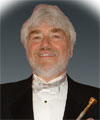
It’s just before sunrise on a summer morning in 1861 in New York Harbor. A solitary bugler, having been roused by the corporal of the guard sounds the brief series of notes that will, in a matter of minutes, summon all the other buglers, drummers and fifes to assemble for the playing of the Reveille sequence. The war, after all, can’t be properly prosecuted without trained field musicians and this is where their training begins: The School of Practice at Governor’s Island.
The instructors are mainly veteran non-commissioned officers, the student recruits teen-agers, the latter being away from home for the first time and struggling to adjust. Soon they will be the conduits for moving masses of men across the fields of places like Manassas and Gettysburg. This is a very serious business. Freeze up or play an incorrect call and men can die.
The drums are rope-tensioned, the heads natural hide and there are but two types, snares and basses. They are carried on slings, without leg rests, the sticks heavy and thick, much the same as those played by the armies of Napoleon and Washington in an earlier time. They are joined by the fifers, dozens of them, playing traditional open hole Bb instruments and sounding melodies heard by the troops of Lord Cornwallis when they surrendered at Yorktown.
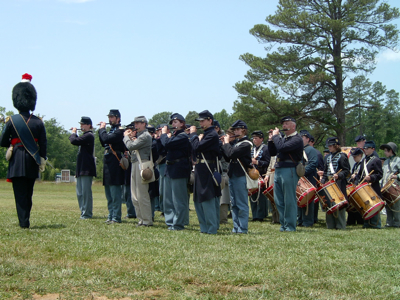
National Civil War Field Music School – Petersburg, VA June 14-16, 2008
Photo by Heather Faust. Used by permission.
Each bugle is of French manufacture, a Clairon D’Ordonnance with a single wrap and a large bell, pitched in Bb. There are no American brass instrument makers with the combination of necessary skills and resources to supply the needs of the Federal and Confederate armies. Some cavalry units will use F or Eb field trumpets, but these are even more difficult to acquire so Bb is the default key.
Every soldier will have the essential calls memorized. Lives depend on it. And all officers (for the same reason) will have sufficient training to sound these should the bugler become disabled.
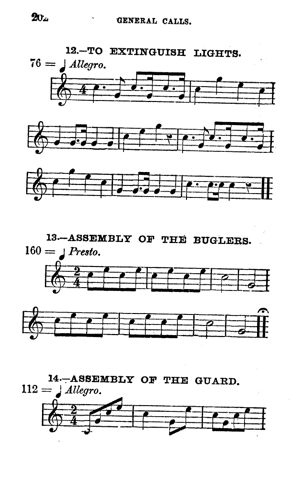
Bugler’s General Calls
(Public Domain)
Drums and fifes will move troops to staging areas, but it’s the bugles who send them into battle. These skills must be learned and perfected such that they are performed flawlessly and under great pressure amid chaos.
The parallels with today’s drum corps are evident, of course. Marching is nothing more than moving together in time, a stylized military dance, as it were. Perfection in performance continues to be sought after and rewarded, and must be delivered when the pressure is on. Drum corps didn’t begin with DCI, DCA, VFW, CYO, Boy Scouts or the American Legion. It was born on Governor’s Island.
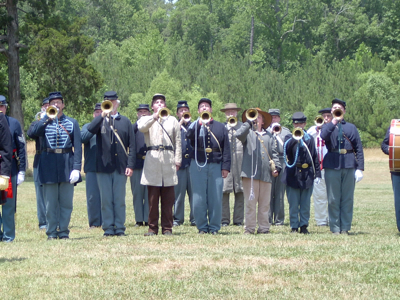
National Civil War Field Music School – Petersburg, VA June 14-16, 2008
Photo by Heather Faust. Used by permission.
A couple of weeks ago at Petersburg, VA, a few hundred folks gathered to re-create that birth. Buglers Hall of Fame member, Jari Villanueva, the “Taps” bugler at Arlington for so many years, supervised the annual National Civil War Field Music School. Re-enactors from across the US came to the famous battleground at Pamplin Park to spend a week-end in the 19th century and live the life of a Civil War musician down to the most precise detail. It was an experience no one who was involved will soon forget. And someone with modern corps experience could not help but feel connected to this history.
A snare drummer stood beneath a chestnut tree to escape the heat as he practiced a piece I remembered hearing at many an I&E competition long ago. “What is that?”, I asked. “The Downfall of Paris”, he replied. “I learned it from my drum teacher years ago.” “And who was he?”, I inquired. “George Tuthill taught it to me when I marched in the Sky Ryders”, he said.
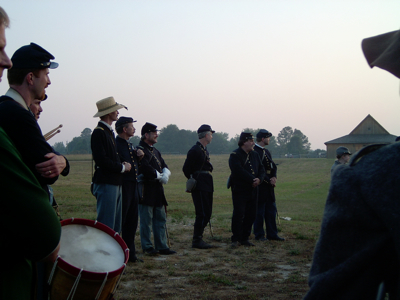
National Civil War Field Music School – Petersburg, VA June 14-16, 2008
Photo by Heather Faust. Used by permission.
In addition to Jari (who played all the calls in “Gods and Generals”) there were a couple of other fair bugle instructors at the event, George Rabbai, former lead trumpet for Woody Herman (heard on several of Ken Burns’ documentary soundtracks), and Doug Hedwig of Juilliard and the New York Metropolitan Opera.
Twyla Tharpe suggests that aspiring artists must earn their ancestors by learning and honoring their stories. Only then is one worthy of carrying forward a tradition. Only then does one have the right to modify the art or alter its direction.
One sweet irony strikes me: It’s not that we have abandoned the key of G. It’s more accurate to say we’ve returned to F and Bb. And if we remove the valves, we’ll actually have bugles, just like that morning in the harbor.
Frank Dorritie is one of the legends of the activity .... a performer, instructor, arranger, adjudicator, and observer over the past 5 decades. Frank has been playing the bugle and trumpet since the 1960s, and has performed with artists like Billy Cobham and Maynard Ferguson. He has instructed and/or arranged for the Blue Devils, Cadets, Santa Clara Vanguard, Cavaliers, Chesterton and Tenri High Schools, the Bushwackers, Bridgemen and a host of others. His audio production honors include 9 Grammy Nominations, 2 Grammy Awards and membership in both the World Drum Corps and Buglers Halls of Fame. He is active internationally as a clinician and adjudicator, holds the DCA Soprano/Trumpet/Tenor Individual titles for 2003, 2005 and 2006. Frank also chairs the Department of Recording Arts at Los Medanos College. His popular brass method book, “Power and Endurance”, is available from Xtremebrass.com. The opinions expressed in this column are strictly those of the author.
Posted by Frank Dorritie on Monday, July 14th, 2008. Filed under Inside the Arc.
